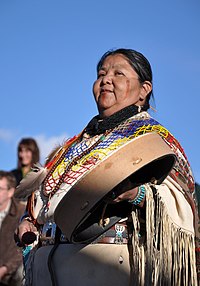Havasupai
| Havsuwʼ Baaja | |
|---|---|

A Havasupai woman in ceremonial attire
|
|
| Total population | |
| About 650 (2010) | |
| Regions with significant populations | |
| Supai, Arizona | |
| Languages | |
| Havasupai, English | |
| Religion | |
| Indigenous, Christianity | |
| Related ethnic groups | |
| Yavapai, Hualapai |
The Havasupai people (Havasupai: Havsuw’ Baaja) are an American Indian tribe who have lived in the Grand Canyon for at least the past 800 years.Havasu means “blue-green water” and pai “people”.
Located primarily in an area known as Cataract Canyon, this Yuman-speaking population once laid claim to an area the size of Delaware (1.6 million acres [650,000 ha]). In 1882, however, the tribe was forced by the federal government to abandon all but 518 acres (210 ha) of its land. A silver rush and the Santa Fe Railroad in effect destroyed the fertile land. Furthermore, the inception of the Grand Canyon as a national park in 1919 pushed the Havasupai to the brink, as their land was consistently being used by the National Park Service. Throughout the 20th century, the tribe used the US judicial system to fight for the restoration of the land. In 1975, the tribe succeeded in regaining approximately 185,000 acres (75,000 ha) of their ancestral land with the passage of the Grand Canyon National Park Enlargement Act.
As a means of survival, the tribe has turned to tourism, attracting thousands of people annually to its streams and waterfalls at the Havasupai Indian Reservation.
Ethnically, the Havasupai and the Hualapai are one people, although today, they are politically separate groups as the result of U.S. government policy. The Hualapai (Pa'a or Pai) had three subtribes: the Plateau People, Middle Mountain People and Yavapai Fighter. The subtribes were divided into seven bands, which themselves were broken up into thirteen regional bands or local groups. The local groups were composed of several extended family groups, living in small villages: The Havasupai were just the Havasooa Pa'a regional band (or local group) of the Nyav-kapai (“Eastern People”) of the Plateau People subtribe.
The tribe had traditionally relied heavily on agriculture, hunting and gathering as their means of survival. Although living primarily above and inside the Grand Canyon, which consists mostly of harsh terrain, the tribe’s reservation was also home to some lush vegetation and beautiful waters. Their name, meaning “the People of the Blue-Green Waters,” reflects this.
...
Wikipedia
